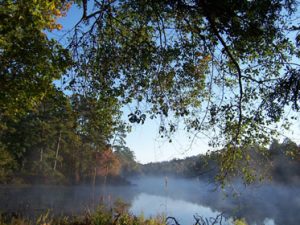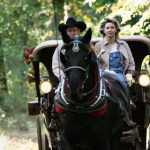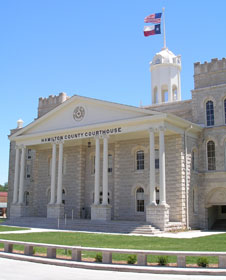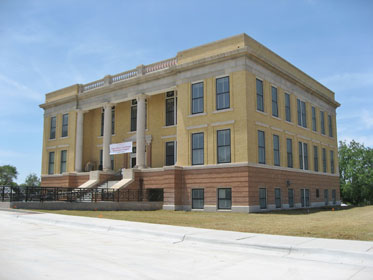Nine years ago County Progress Magazine launched a series dedicated to the restoration and renovation of our county capitols. Titled “Courthouse Trails,” this special section recaps the efforts of counties across the Lone Star State who have taken special measures to restore their capitols to their original splendor and/or launch comprehensive renovation projects to ensure safety and workability, culminating in the proud rededication of their courthouses.
Our coverage to date includes:
- March 2003: Ellis, Grimes, Hopkins, Milam and Shelby counties
- August 2003: Erath, Donley, Lampasas, Llano and Shackelford counties
- February 2004: Atascosa, Gray, Goliad, Parker and Red River counties
- September 2004: Hudspeth, Lee, Presidio, Sutton and Val Verde counties
- February 2005: Dimmit, Jeff Davis and Wheeler counties
- September 2005: Archer, Bexar, Denton and Fayette counties
- February 2006: Harrison (exterior completion), Maverick, Rains and Wharton counties
- August 2006: Bee, Lamar, Lavaca, and Nueces counties
- February 2007: Cameron, Cooke (exterior completion), DeWitt and Menard counties
- August 2007: Bosque, Leon and Williamson counties
- February 2008: Johnson County
- August 2008: Dallas County
- August 2009: Harrison County (interior completion)
- February 2010: Kendall and McCulloch counties
- September 2010: Kenedy County
- February 2011: Brooks County
- September 2011: Harris, Mills, San Augustine and Trinity counties
- February 2012: Cooke County (interior completion)
- September 2012: Cass, Hamilton and Roberts counties
As your courthouse project nears completion, please contact us at Julie@zacpubs.com so we can feature your county is this special section.
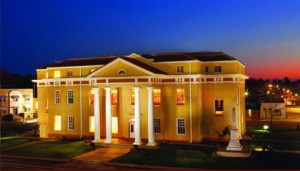 Cass County Courthouse – Linden
Cass County Courthouse – Linden
Completed in 1861, the Cass County Courthouse is the oldest continuously functioning courthouse in the State of Texas. Originally a red-brick, Greek 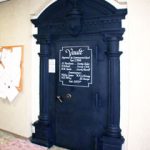 Revival Style building, the county capitol was
Revival Style building, the county capitol was 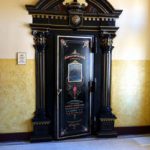 gradually modified and expanded to resemble the Classical Revival Style structure it is today. A 1933 fire did extensive damage, and the building was repaired, expanded and beautified.
gradually modified and expanded to resemble the Classical Revival Style structure it is today. A 1933 fire did extensive damage, and the building was repaired, expanded and beautified.
Using funding from the community and a grant from the Texas Historical Commission, ARCHITEXAS of Dallas was commissioned to restore the building to its appearance at the time of its 1934 rededication, with RBR Construction as construction manager.
The $5 million-plus project largely involved reversing the changes made to the building in 1980, at which time an addition was constructed, mosaic tile floors were covered, ceilings were lowered, and the plaster walls furred out. Once these modern changes were removed, the underlying historic materials were carefully restored.
 While the project involved restoration of the historic design, it also included the integration of modern infrastructure necessary for the building to function as a modern courthouse. New plumbing and electrical and mechanical systems were carefully concealed within walls and ceilings. In order to accommodate the new equipment and to offset the space lost by removing the 1980 addition, the basement of the building was expanded to house mechanical and storage areas. The building also underwent changes necessary to bring it into compliance with life-safety codes and make it accessible to all members of the community. Of particular note are the restoration of the historic exterior paint colors, the rich finishes of the district courtroom, and the ornamental paintwork of the 1880s Diebold Vault.
While the project involved restoration of the historic design, it also included the integration of modern infrastructure necessary for the building to function as a modern courthouse. New plumbing and electrical and mechanical systems were carefully concealed within walls and ceilings. In order to accommodate the new equipment and to offset the space lost by removing the 1980 addition, the basement of the building was expanded to house mechanical and storage areas. The building also underwent changes necessary to bring it into compliance with life-safety codes and make it accessible to all members of the community. Of particular note are the restoration of the historic exterior paint colors, the rich finishes of the district courtroom, and the ornamental paintwork of the 1880s Diebold Vault.
The community celebrated its restored courthouse in a rededication ceremony on Feb. 18, 2012. – Information provided by A R C H I T E X A S – Architecture, Planning, and Historic Preservation Inc.
Located in the heart of the Piney Woods Region of Northeast Texas, Cass County’s natural beauty is enhanced by wildflower trails and area lakes. In fact, Wright-Patman Lake, Lake-O’-the-Pines, and Caddo Lakes form a triangle with Linden as the center.
Organized in 1846, the county was named for Lewis Cass, an advocate of the annexation of Texas. When Marion County was carved out of Cass County in 1860, the original Cass County seat of Jefferson went to Marion, and Linden became the new home of county government.
Linden, one of the oldest towns in Texas, boasts a rich cultural and musical heritage. Musicians who have called Linden home include: Scott Joplin – founder of Ragtime Jazz; Aaron “T-Bone” Walker – Daddy of the Blues; Don Henley – Rock & Roll great, co-founder of the Eagles, and nationally honored preservationist; and Richard Bowden – America’s “Most Famous Unknown Entertainer.” Linden’s Music City Texas Theater draws audiences from the Atlantic shores to the Pacific.
– founder of Ragtime Jazz; Aaron “T-Bone” Walker – Daddy of the Blues; Don Henley – Rock & Roll great, co-founder of the Eagles, and nationally honored preservationist; and Richard Bowden – America’s “Most Famous Unknown Entertainer.” Linden’s Music City Texas Theater draws audiences from the Atlantic shores to the Pacific.
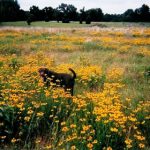 The Linden Wildflower Trails of Texas Festival pays homage to the area’s beautiful wildflowers each spring. The festival, conducted on the courthouse square in Linden, features a parade, along with art, quilt, cake and car shows and food of all kinds. Other events include a 5K Run, and the Little Miss Wildflower Trails Pageant.
The Linden Wildflower Trails of Texas Festival pays homage to the area’s beautiful wildflowers each spring. The festival, conducted on the courthouse square in Linden, features a parade, along with art, quilt, cake and car shows and food of all kinds. Other events include a 5K Run, and the Little Miss Wildflower Trails Pageant.
Music lovers, along with hunting and fishing enthusiasts, are frequent visitors to Cass County. In fact, the lush countryside,water access, and close proximity to Texarkana, Shreveport, Marshall and Longview make Linden and the surrounding area an ideal retirement and bedroom community.
Hamilton County Courthouse – Hamilton
The second Hamilton County Courthouse was built in 1887 in Second Empire Style, and significantly remodeled and expanded in 1931, changing to a unique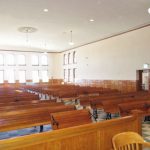 combination of Neo-Classic, Neo-Gothic and Mission styles. This Central Texas landmark was restored in a $6 million project including both interior and exterior historic preservation and restoration. Komatsu Architecture spearheaded the design effort, with RBR Construction as construction manager.
combination of Neo-Classic, Neo-Gothic and Mission styles. This Central Texas landmark was restored in a $6 million project including both interior and exterior historic preservation and restoration. Komatsu Architecture spearheaded the design effort, with RBR Construction as construction manager.
Exterior restoration included native Hamilton County limestone repairs and cleaning, restoration of  original 1931 wood windows and doors, and replication of the 1931 metal cupola. Site work included restoration of a 1931 concrete bench; installation of new concrete parking over the geothermal well field; construction of a new, compatible mechanical enclosure; and the construction of a foundation drainage system incorporating French drains, sumps, and sump pumps to alleviate basement moisture intrusion problems.
original 1931 wood windows and doors, and replication of the 1931 metal cupola. Site work included restoration of a 1931 concrete bench; installation of new concrete parking over the geothermal well field; construction of a new, compatible mechanical enclosure; and the construction of a foundation drainage system incorporating French drains, sumps, and sump pumps to alleviate basement moisture intrusion problems.
Interior restoration efforts included new elevators, fire suppression/fire ![Hamilton-Scenic-Post-Office-WPA-mural[1]](https://countyprogress.com/wp-content/uploads/2012/09/Hamilton-Scenic-Post-Office-WPA-mural1-150x150.jpg) alarm and security system installation, new ADA-accessible restrooms, and restoration of the original full district courtroom volume, including restoration and replication of the original wood and cast iron pews. New electrical systems and ground-source heat pump (geothermal) HVAC systems were fully integrated into the historic interiors with minimal visual impact.
alarm and security system installation, new ADA-accessible restrooms, and restoration of the original full district courtroom volume, including restoration and replication of the original wood and cast iron pews. New electrical systems and ground-source heat pump (geothermal) HVAC systems were fully integrated into the historic interiors with minimal visual impact.
The interior restoration included all new finishes predicated on investigations by historic finishes conservationists for paints, woods, and metals finishes.
Hamilton County rededicated its fully restored temple of justice on April 28, 2012. The Texas Historical Commission has cited the Hamilton County Courthouse as a unique example of an eclectic style of historic courthouses in Texas which retained its historically significant character notwithstanding the fundamental changes to its original architecture. – Information provided by Komatsu Architecture
Sheltered in a pleasant valley of Pecan Creek, the county seat of Hamilton ![Hamilton-Scenic-eight-point-with-doe-and-fawn-800x600[1]](https://countyprogress.com/wp-content/uploads/2012/09/Hamilton-Scenic-eight-point-with-doe-and-fawn-800x6001-150x150.jpg) delights home folks and visitors alike with its scenic beauty every season of the year. Lovely trees and historic homes and buildings surround the majestic Hamilton County Courthouse, the center of life and commerce of the community.
delights home folks and visitors alike with its scenic beauty every season of the year. Lovely trees and historic homes and buildings surround the majestic Hamilton County Courthouse, the center of life and commerce of the community.
Hamilton County, organized in 1858, boasts rolling prairies, cultivated farmlands, tree-shaded rivers and creeks flowing through hills and valleys, as well as small, rural communities. Agriculture continues to play a major role in the economy of the county; in addition, a full range of retail businesses, specialty shops, some featuring locally produced merchandise, and professional offices flourish. The county produces limited oil, gas and gravel.
Hamilton’s moderate climate affords the possibility of year-round fishing, boating, and other water sports at City Lake, Cowhouse Creek, the Leon River, and nearby Lake Proctor. Deer, quail, dove, duck and turkey hunting draws hunters to Hamilton from early September through early spring. Small game hunting for rabbit, fox, squirrel, bobcat and raccoon is also conveniently available.
 The Annual Hamilton County Dove Festival in early September celebrates the opening of dove season with a citywide event reminiscent of an old-fashioned county fair and rodeo. The Dove Festival attracts some 5,000 visitors to Hamilton.
The Annual Hamilton County Dove Festival in early September celebrates the opening of dove season with a citywide event reminiscent of an old-fashioned county fair and rodeo. The Dove Festival attracts some 5,000 visitors to Hamilton.
The highly acclaimed Hamilton Civic Theater performs five live shows each year beginning in the spring and ending with a children’s Christmas pageant. Under ongoing renovation, the Hamilton Fine Arts Center houses exhibits, seminars, art and dance classes and more. H – Information courtesy of the Hamilton Chamber of Commerce and Economic Development Corporation
Roberts County Courthouse – Miami
The Roberts County Courthouse was designed in 1913 in the Classical Revival style popular in early 20th century public architecture. The recently restored temple of justice boasts columned porticos above monumental stairs. A cast stone balustrade frames a red clay mission tile roof above the two entrances. All new building systems were carefully integrated into the project. The district courtroom features a beautifully restored plaster frieze contrasting with decorative stenciled freizes in all other spaces. A hexagonal ceramic tile floor with inlaid mosaic patterns, including a large star at the main corridor crossing, complement the restored marble base, marble wainscot, and plaster walls.
The $4 million restoration project was initiated some 15 years ago when the  county received a grant from the Texas Historical Commission (THC) for energy planning. This evaluation led to a new boiler and sparked a general interest in returning the courthouse to its original glory. The courthouse was actually in near-original condition, having missed many of the expansions and facelifts that other courthouses underwent. The historic window panes, mosaic tiles, and courtroom seating were just a few of the original features that were still in use.
county received a grant from the Texas Historical Commission (THC) for energy planning. This evaluation led to a new boiler and sparked a general interest in returning the courthouse to its original glory. The courthouse was actually in near-original condition, having missed many of the expansions and facelifts that other courthouses underwent. The historic window panes, mosaic tiles, and courtroom seating were just a few of the original features that were still in use.
Years later, the county received additional THC grant money, at which time Preservation Associates (a joint venture of Michael Peters, architect, and Grimes & Associates Consulting Engineers, LP) was selected as the design team. Following the issuance of a subsequent grant in 2009, the restoration work began with Grimes & Associates as the construction manager.
The restoration of the courthouse incorporated state-of-the-art, energy-efficient components, including ground source heat pumps, as well as a new electrical system, energy-efficient light fixtures, and a new data/communication system.
The Roberts County Courthouse was rededicated on June 2, 2012.
– Grimes & Associates contributed to this article.
Roberts County is located in the east central portion of the Texas Panhandle, approximately 75 miles east of Amarillo along scenic U.S. Highway 60. Located in and along Red Deer Creek, the county seat of Miami offers a quaint respite for visitors to the Texas Panhandle. Centuries-old cottonwood trees, colorful mesas, and cap rocks offer visitors a unique contrast to the usual flat, monotonous scenery of the Panhandle.
The northern half ofRobertsCountyis bisected by the tributaries and terrain breaks of the once powerfulCanadian River. Historically, the Canadian was an invaluable water source for early Indian tribes, as well as later migrating settlers. Inevitably, this mix evolved into noted Indian battles including the Battle of Adobe Walls, and other more minor skirmishes which have since become known as the “Red River Wars.”
Visitors to Miami should heed one small bit of caution. Miami is  pronounced as “MiamA” not “MiamY.” Many visitors and newcomers have made this mistake in pronunciation, which is quickly pointed out by vigilant locals. When questioned as to this variance in pronouncement, most natives will reply, “We want to distinguish our beautiful part of the world from that in Florida.”
pronounced as “MiamA” not “MiamY.” Many visitors and newcomers have made this mistake in pronunciation, which is quickly pointed out by vigilant locals. When questioned as to this variance in pronouncement, most natives will reply, “We want to distinguish our beautiful part of the world from that in Florida.”
The Roberts County Museum is noted for its outstanding collection of early Indian artifacts, showcasing early lifestyles and necessities required to eke out a meager living in the early eastern Texas Panhandle.
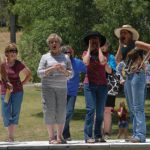 If a visit to Roberts County happens to fall on the first Saturday in June, everyone is cordially invited to drop in and attend the National Cow Calling Championship and Steak Cook Off. This event is the official opening of summer for the county and an opportunity for past and present residents to come together and renew old acquaintances and make many more new ones.
If a visit to Roberts County happens to fall on the first Saturday in June, everyone is cordially invited to drop in and attend the National Cow Calling Championship and Steak Cook Off. This event is the official opening of summer for the county and an opportunity for past and present residents to come together and renew old acquaintances and make many more new ones.










